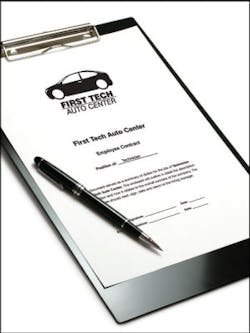If you were to walk into Murrieta Auto Repair in Murrieta, Calif., a year ago, it wouldn’t have taken more than 20 minutes to pick out its owner, Chris Christianson. All the other staff, they would be slowly going about their business, dawdling at simple tasks.
Christianson? He was the one “running around like a chicken with its head cut off.”
“It’s pretty much the same if you walk into any struggling shop, anywhere you go,” Christianson says. “Workers are waiting around for instruction, and the owner is running around trying to do everything, explain everything.
“That’s how I was. I opened my shop about five years ago, and I was working harder than I’ve ever worked in my life, and we weren’t getting results. It was like a constant game of catch-up.”
—T.J. Relilly, owner, Same Day Auto Service
Within the last year, though, everything has changed.
Christianson’s shop gets cars in and out quicker. They get repairs done more efficiently. Productivity has shot way up, and monthly revenue totals have increased from barely above $20,000 a year ago to where they’re reaching the high-30s every month in 2012.
And it all came from one thing: position contracts that spelled out each employee’s duties.
“Honestly, it’s what saved my shop—it’s what saved me,” he says with a laugh. “I was a ball of stress. I don’t know what I would’ve done if we didn’t put those in place and get things done.”
Industry consultant and shop owner T.J. Reilly says position contracts, which are essentially detailed job descriptions that hold employees accountable, are the first and, arguably, most important step in taking control of your business and increasing your shop’s productivity.
“There are a lot of misconceptions about what these are and how to use them,” Reilly says. “But the fact is, they will change your business. They’ll free you up to do the things you have to do as an owner, and they will make your entire staff more productive.”
What is a position contract?
A number of years ago, Reilly had the same problems with his shop, Same Day Auto Service in Clackamas, Ore., that many of his clients now have: “The business would run great when I was there, really efficient. The second I left, though, it was a mess.”
And that’s not due to any amazing skills Reilly or any other owner might possess. It’s because the staff lacked direction, it lacked the decision-making know-how to get things done without the boss around. And that’s the boss’s fault, Reilly says.
“A real job description is a living document that is always changing,” Reilly says. “It contains every aspect of their job they are responsible for—every task and what’s expected of them—and it tells them exactly how they’re supposed to do it.”
Ultimately, it holds employees accountable to the work they’re expected to do. Employees must sign off on the document, creating a contracted agreement for both sides to uphold their responsibilities.
Creating a position contract
It may sound daunting, Reilly admits, but it doesn’t have to be, and creating these for each and every staff member, including managers and owners, will be the best managerial decision you make, he says.
Reilly shared his biggest tips on how to go about doing this.
1. Start with your shop’s lowest-paid employee:
People are intimidated by the process, Reilly says, and starting with the lowest-paid staff members lets you start small.
“If you started with a service advisor or technician, there’s just so much that will go into it,” he says. “You might throw up your hands and stop right there.
“But with, say, a clean-up type person in your shop or a parts driver, it’s more simple.”
Then, Reilly says, work your way all the way up.
2. Pick out the most important aspects first:
With each employee, Reilly asks himself, “What is the most important thing to me about that position?” And then he goes from there.
“For our company, the most important things are the ones where there is customer interaction,” he says. “So, that’s where I start.”
Then, Reilly goes through everything he expects from that employee and records it all in the document.
3. Describe the processes:
It’s not enough to tell employees what to do, Reilly says, you have to tell them how to do it.
Basically, Reilly says, this is where the contract turns into a “best practices” manual for the employee. You describe the standard operating procedures for each situation, whether it’s as simple as cleaning a bathroom or as complicated as a full vehicle inspection.
4. Don’t worry about finishing—you never will:
The goal is to encompass every aspect of the job an employee will face. It’s impossible to get it all finished, because new situations arise every day.
Reilly says to continually update it and review it to make sure you have the most up-to-date practices for every task of an employee’s job.
5. Give out copies, and get them signed, as soon as possible.
Reilly has had clients “start” their position contracts, only to have them sitting in their desk months later without the employees having any knowledge of it.
“They say they want to wait for it to get done before they give it out,” he says, “but that’s never going to happen.
The ‘myth’ behind ownership
Reilly is quick to point out that creating employee contracts wasn’t something he came up with on his own. He read about it in the best-selling business book The E-Myth: Revisited by Michael Gerber.
(Note: The E-Myth Revisited is the updated, revised edition of Gerber’s original bestseller, The E-Myth.)
The “E-Myth” refers to the “entrepreneurial myth” that being good at a particular trade—whether it’s mechanical repair or making chairs—will lead to success as a business owner in that industry.
The book covers business management principles, ranging from leadership techniques to, yes, creating position contracts.
“It is really a book that I’d recommend every single owner to read,” Reilly says. “That’s what really kicked me in the pants to make some needed changes in my business.”
“Once you get something down, even if it’s just one item of their job, give it to them. Tell them it’s a living document, it’ll be updated as you go, but you want them to have it right away.”
Reilly says to print it out—even if you have it stored and accessible on your shop’s computer system, like he does—just to make sure you go through the process of explaining it and giving it to them. When all duties are explained and understood, the employee and manager should sign the contract. It should be signed again after each change.
“The point is getting it in place and going through the practice of reviewing and adding to it,” he says.
How to use it
A position contract is a powerful human resources tool, Reilly says, as it can become the basis of training, reviewing and evaluating employees.
“Everything they’re responsible for, even how to do it, is in there, and they know it,” he says. “So, it keeps them in check and keeps the evaluation and training process ongoing.”
When new processes are added, Reilly sits the employee down for a one-on-one meeting to explain it. The key, he says, is to make sure they understand why the processes are needed and why they are to be performed in those specific ways.
“I may hand them an updated version and tell them to find the change,” he says. “It forces them to review everything in there before coming back to you to then discuss it.”
The most typical use of the documents, Christianson says, is the daily applications of the processes.
“Everyone knows what they’re doing,” he says, “and unless it’s a totally new situation that’s never been faced before, they don’t need to track you down to ask a million questions. They consult the job description, and they know what to do and how to handle it.”
Christianson says that if you walked into his shop today, you won’t see him running around anymore. Instead, he’s now freed up to work on improving his business—the marketing, the finances, the planning, etc.—rather than putting out fires. And it’s all because his employees have a clear understanding of their duties, based on their position contracts.
“I really think that a lot of [shop owners] don’t really understand what it does in your shop; I didn’t,” he says. “But it’s made all the difference.”
About the Author

Bryce Evans
Bryce Evans is the vice president of content at 10 Missions Media, overseeing an award-winning team that produces FenderBender, Ratchet+Wrench and NOLN.
